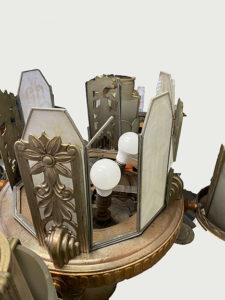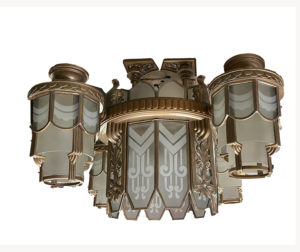Warner Grand Theater Historic Lighting Restoration Project :2020
The process of Historic Restoration, Repair and Reproduction requires a variety of skills. A comprehensive knowledge of Historic Design, Engineering, Metal and Glass Fabrication, 3D modeling, Casting, Lighting efficiency, Metallic finish skills, Leaded Glass and Etched Glass knowledge are all necessary. Each new job is like a puzzle. Investigation, research, and innovation are required to reach a solution that will hold up to the sharp eyes of historians and please the stakeholders while conforming to current codes.
We recently worked on a Restoration project for the Warner Grand Theater in San Pedro, CA. This theater is a great example of the fabulous movie palaces that were built in the 1920 and 30’s. At this time in history, talking movies were the most fantastic and exciting technology that had ever come along for most people. The fact that it was available to the masses for only a quarter made it extremely popular. Thousands of people went to the movies every day from early morning to late at night. They could not to get enough of it. Most of the population in the United States at that time had never traveled further than a few miles from their place of birth. These new “Talkies” transported them to new exotic places and brought the best and most exiting entertainment to their door steps. Not only were the movies exciting, the Movie Palaces were a big part of the package. The buildings were enormous and elaborate. The decoration was exotic and exciting. The Grand Vision is an explosion of Art Deco style with every view a feast for the senses
One hundred years later, these movie houses are still loved and have become important civic centers for their communities. They also need a lot of TLC.
 We received the 1929 vintage fixtures in pretty sad shape. Over the years, parts were broken and missing, the finishes were completely degraded and the electric system was a mess. The zinc came that was used to secure the glass had failed over time and resulted in many of the etched glass parts to break or disappear. A critical light diffuser was missing from all the fixtures and there was no record of what it looked like. It may have been a disk of glass that had been broken when changing the light bulbs. The chandeliers were custom made for theater and it would have been very difficult to get replacement parts.
We received the 1929 vintage fixtures in pretty sad shape. Over the years, parts were broken and missing, the finishes were completely degraded and the electric system was a mess. The zinc came that was used to secure the glass had failed over time and resulted in many of the etched glass parts to break or disappear. A critical light diffuser was missing from all the fixtures and there was no record of what it looked like. It may have been a disk of glass that had been broken when changing the light bulbs. The chandeliers were custom made for theater and it would have been very difficult to get replacement parts.
We were able to create a replacement part that shared design elements with the original chandelier. Our design historian and engineering department created a model for the new part using our 3D computer program.
The Zinc Came that was used to hold the glass in place had broken at the solder joints and had to be replaced. Zinc Came that was typically used in these types of chandeliers creates several problems. In order to replace broken or missing glass the chandelier must be removed from the ceiling. The Zinc Came must then be dis-assembled and a new matching piece of glass is inserted and the Came is then re-soldered. The Came turns grey over time and can not be painted to match the rest of the chandeliers without masking off each piece of glass. The most serious problem is this type of fabrication will fail over time as the solder joints disintegrate.
We chose to invent an alternate fabrication method that would solve all these problems. It took a bit of trial and error, but we were successful. With our plan in place we started the restoration process.
The slow process of cleaning, repairing, replacing, re-finishing and re-assembling would take place over many hours until the final assembly would be completed. The finished product would then be ready to be-reinstalled in the theater to greet guests and provide a another 100 years of magic. 

